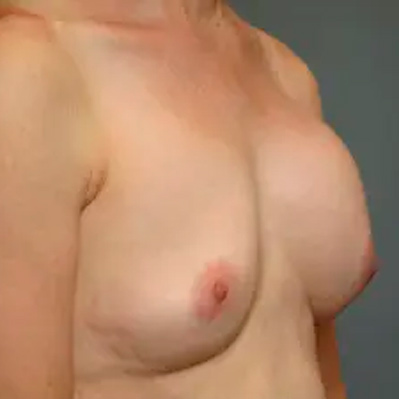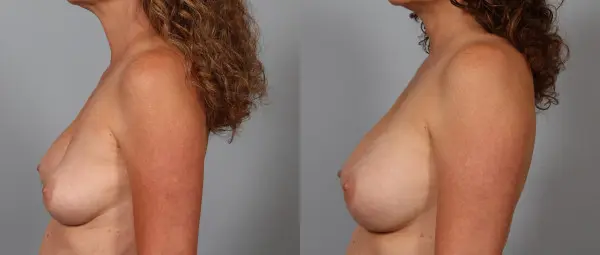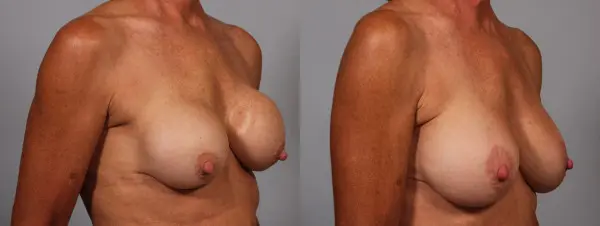Breast Implant Revision
- When first put in, breast implants usually look great, but aging breasts and old implants can need a touch-up in order to remain youthful and attractive
- Problems that can develop over time include capsular contracture, saline implant deflation, implant migration, asymmetry or unevenness, and gel implant rupture.
- Patients seek Dr. Duncan’s care for these concerns because of her attention to detail and natural and tasteful outcomes.
Breast implant revision surgery is a specialized procedure designed to replace or correct previous breast augmentations, addressing concerns such as implant size changes, implant rupture, capsular contracture, or aesthetic preferences. At Plastic Surgical Associates in Fort Collins, CO, board-certified plastic surgeon Dr. Diane Duncan offers expert breast implant revision surgery to help women achieve their desired look while improving comfort and confidence. Whether you’re experiencing complications or simply wish to update your implants, Dr. Duncan provides personalized care and natural-looking results. Serving patients throughout Northern Colorado, including Loveland, Windsor, and Greeley, our team ensures a smooth and supportive experience tailored to your needs.

REAL PATIENT STORY
This 47 year old had saline implants put in about 12 years before she returned with a right implant deflation and left capsular contracture. A contracture occurs when too much scar tissue forms around the implant, making it sit too high and feel hard.
47 year old before corrective surgery
to six weeks following removal of old saline implants, with conversion to gel implants under the pectoral muscle by Dr. Duncan
View Additional Secondary Breast Implant Surgery Before & Afters click here.

Why Choose Us?
When it comes to your aesthetic journey, choosing the right provider makes all the difference. Plastic Surgical Associates is dedicated to meeting your unique needs, whether you're seeking minor or major aesthetic transformations, addressing specific health concerns, or looking to enhance your overall well-being. Our Fort Collins plastic surgery center offers tailored solutions, ensuring a comprehensive approach to your care. Experience personalized services that align with your individual goals and contribute to a more vibrant and fulfilling lifestyle.
Why Patients Trust Us!
Skilled & Experienced Team
Dr. Duncan and our expert staff bring years of advanced training and experience to deliver exceptional results.
Attentive & Compassionate Care
We take the time to listen, ensuring you feel heard, valued, and confident every step of the way.
Cutting-Edge Techniques
Utilizing the latest technology and surgical advancements, we prioritize safety, comfort, and optimal results.
Proven Patient Satisfaction
Our Fort Collins patients’ glowing testimonials and stunning transformations speak for themselves.
Capsular Contracture
Capsular contracture occurs in almost a third of women undergoing breast implant surgery. This can happen when there is bleeding into the pocket, or if inflammation occurs. In some cases, a sudden, delayed-onset contracture can occur with a serious local or systemic infection, such as a dental abscess or urinary tract infection. The 52-year-old woman below had a hematoma due to trauma and developed a very tight pocket on the left.
Right: 52-year-old with left contracture following hematoma evacuation after trauma. Left: 6 weeks after open capsulotomy and implant replacement.
Saline implant deflation
Saline implants have a relatively short life statistically as compared to cohesive gel implants. The average lifespan of a saline implant is about ten years. Deflation results in a sudden loss of volume, which feels like an emergency to many women when it occurs. While most patients are aware of this risk at the time of surgery, ten years can pass very quickly. The risk of deflation, implant migration, rippling, and lack of upper pole fullness are several reasons why I tend to use cohesive gel implants instead of saline.
The woman below had her saline implants for many years. One day she noticed a funny sensation on her left side, and over the next 24 hours lost all of the volume from that side’s implant.
Left: 44-year-old with a left saline implant deflation. Right: Six weeks following removal of saline implants and replacement with “gummy bear” cohesive gel implants.
I removed her saline implants on both sides and opened up her tight pockets. Capsular contracture can contribute to deflation, as it can cause a peripheral fold with a weak point—the “fold flaw phenomenon” — which then creates a pinpoint hole causing the fluid to leak out. Her saline implants were replaced with “gummy bear” implants. Her new implants should last 20- 25 years unless there is severe trauma to the implants.
Implant Size Change
A size change is not an infrequent request from my patients. The woman below wanted smaller implants. When she was younger, having larger breasts was important to her. As she aged, she noted that her implants made her look a little thick around the midsection; she wanted to look more slender. She opted to have her old implants removed and smaller implants placed.
46 year old had saline implants 14 years ago. She had right bottoming-out and left lateral implant migration (left). Six weeks after replacement of her 325cc saline implants, and replacement with 275 cc implants (right). In order to shrink up her skin envelope, a “scarless” radiofrequency assisted breast lift was performed.
Note that while she is smaller after surgery, she also is less droopy. Normally, going down in size causes more, not less, droopiness because larger implants fill out the skin more. Internal tightening with radiofrequency was needed in order to shrink her skin envelope. This minor to moderate lift can be done without adding additional scars.
Poor Placement
In some cases, the problem can be caused by poor placement of the original implants. This can be corrected by switching the position of implants from sub-glandular to sub-pectoral, and by enlarging the pocket. The woman pictured below had implants put in by a physician who was not a plastic surgeon. The implants were under the soft tissue only, and her pockets were quite tight. They were saline implants and were overfilled so they resembled a ball. This is not a natural appearance for anyone.
Left: 53-year-old after TUBA: transumbilical breast augmentation with saline implants in the submammary position. Right: Six weeks after corrective surgery by Dr. Duncan.
I removed her saline implants and the surrounding scar tissue and replaced them with “gummy bear” implants using a “dual plane” approach. This means I placed them under the pectoral muscle above, under breast tissue below. I corrected the pocket position so that a more natural appearance could be achieved.
When implants are placed under breast tissue alone, the implant tends to “ball up” and fall forward into the tube of skin that surrounds it. A torpedo-like look is not uncommon in patients who have had their implants done this way. The result, over time, is overprojecting breasts that also droop. A periareolar mastopexy was needed in this case to correct the skin laxity.
It is difficult, once surgery has been done and a problem occurs, to entirely correct the appearance, but in most cases, dramatic improvement in appearance can be achieved. The result, right, shows a much more natural and tasteful look.
Bottoming Out (Implant Migration)
Another common problem with saline implants is “bottoming out”, or migration of the implants out into the axillary region or down towards the belly button. This can result in upper pole flatness, a poor implant position with a central gap between the implants, rippling, and sometimes the areola peeking out of a swimsuit.
Left: 47-year-old 9 years after saline implant placement in the subpectoral position. Her original incisions were very low. Right: Six weeks following the creation of a higher inframammary crease and replacement with gel implants.
Implant migration has occurred; they sit way too low. Lower crease fixation was needed to close the excess pocket space. Gel implants have better upper pole fullness.
This patient’s implants initially looked good, but over time the weight of the saline implant caused the lower outer pocket to enlarge. This effect is potentiated by lack of support garments such as not wearing a bra. Very thin patients without much soft tissue support are prone to developing this problem as well. Correction can include removal of the saline implants and replacement with cohesive gel, or “gummy bear” implants, and a capsulorrhaphy, or tightening of the lower outer pocket.
Change of Implant Profile
Overprojecting implants due to high profile: most of my patients prefer a tasteful and natural appearance. When high profile implants are used, their narrow base and “torpedo” like projection creates an unnatural look that many women dislike.
The problem is more noticeable when the submammary location is used.
Left: 44-year-old had silicone implants placed 22 years ago. Right: Six weeks after saline implant removal and conversion to cohesive gel implants in the subpectoral position.






